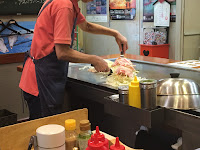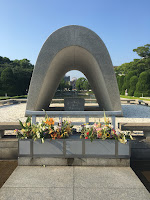Over the past month, we've had two groups of visitors from the US! Katie and Kelly visited us for nine days at the beginning of July and Katie and Tim visited us for twelve days after that! With both groups, we took a day-trip to Hiroshima and the neighboring island of Miyajima. Even though is was technically rainy season - we lucked out with beautifully sunny (yet scorching) days.
The day started with a 2.5-hour Shinkansen ride to Hiroshima, followed by a 35-minute local train and 10-minute ferry ride to Miyajima. After exploring Miyajima, we enjoyed Hiroshima-style okonomiyaki (made with noodles) for lunch before spending some time in Hiroshima. We arrived back in Nagoya just before 10pm.
Here's a bit more about both places...
Miyajima Island is about 20km from central Hiroshima and has been named one of the three most scenic spots in all of Japan. Miyajima is most famous for the great Torii - which acts as a boundary between the spirit and the human worlds. The first torii was built in 1168 and it has been rebuilt eight times - 1875 being the most recent rebuild. Interestingly, the torii is not buried deep in the sand - it is actually supported by its own weight. The box-shaped upper portion is also filled with about seven tons of stones the size of a human fist. The torii is painted such a bright color because bright colors were (and still are) believed to keep the evil spirits away.
Visitors can view the Torii by simply walking around the island - or get even more up close and stunning views from within the Itsukushima Shrine. There is documentation about the shrine's existence dating back to 593. Apparently, before the shrine was built many people worshiped the island itself as a goddess. Like many places in Japan, Itsukushima Shrine was destroyed many times - by fire, weather, etc. - and changes were made to its design each time. The Shrine standing today was built in 1571, named a Natural Treasure in 1952, and became a UNESCO World Heritage Site in 1996.
One of the neatest things about the Great Torii and Itsukushima Shrine is that they look different depending on the height of the tide. The first time I visited, it was high tide and both the torii and the shrine looked as though they were floating in the water. The second time I visited, it was between high and low tide. The shrine did not have any water under it - and the torii was submerged in much shallower water. We were able to walk about half way out to the gate. Hopefully next time, we'll go at low tide - so that I can take a picture standing under the gate...and then decide at which stage of tide I like the torii and shrine best!
High Tide
 Miyajima Island also many shops that make and sell momiji manju (small cakes in the shape of a maple leaf and filled with sweet bean paste, custard or chocolate). I had never seen or tried this treat before - but enjoyed it quite a bit! I think my favorite flavors were chocolate and peach because neither of them had the consistency of bean paste! ;)
Miyajima Island also many shops that make and sell momiji manju (small cakes in the shape of a maple leaf and filled with sweet bean paste, custard or chocolate). I had never seen or tried this treat before - but enjoyed it quite a bit! I think my favorite flavors were chocolate and peach because neither of them had the consistency of bean paste! ;)
After exploring Miyajima, it was time for lunch. Hiroshima is famous for their version of okonomiyaki (the cabbage pancake I blogged about earlier). Hiroshima's okonomiyaki is different because it contains either udon or soba noodles in addition to the cabbage and other ingredients. As I was researching the best places to eat okonomiyaki, I came across Okonomi-mura. Okonomi-mura is actually a collection of little stalls (each a different restaurant) where you can eat okonomiyaki (and they will cook it right in front of you). There were probably about 10-15 stalls on three different floors of the building. Not knowing which was better than the other - I randomly picked a place that had the most people each time we visited - and we were not disappointed. I think the "safety" of Japan's food is rubbing off on me because I am not sure I would have even entered a place like this in the US. The building is quite old and run down - but as always - the stalls were spotless and the food was delicious!
All of our visitors preferred Hiroshima-style okonomiyaki, Kaz prefers Osaka-style, and I love both! Hiroshima
Hiroshima
Most of our time in Hiroshima was spent wandering through the Hiroshima Peace Memorial Park. The park contains many memorials, monuments, and museums for visitors to view. First we visited the Hiroshima Peace Memorial Museum (currently only half of it is open due to construction) and then we walked around some of the highlighted monuments and memorials.
I have to say that I was initially nervous about visiting the museum - I guess it was the fact that America bombed Japan and I am an American in Japan. I mean, I know I didn't play a role in the bombing...and I know that Japan did bad things to the US in the past...but there was just an uncomfortable feeling in the pit of my stomach. I was also expecting to come away from the museum and city with an overwhelming feeling of sadness. And, while, I definitely felt a lot of grief and sadness - I was overcome by the message of peace and hope. Actually, when reflecting on the visit, all of our visitors agreed that the message they took from Hiroshima was one of hope as well.
I was also surprised by the size of Hiroshima. I thought that it would be rather small - but it's a pretty big and bustling city. It is absolutely amazing to me that this city was completely destroyed in 1945 and by 1958 - it's population exceeded post-war numbers. And, now it's the 11th biggest city in Japan. That definitely says a lot about the resilience of the people in Hiroshima. And, the people there were also some of the friendliest I've encountered thus far in Japan.
Overall, I found the museum to be very neutral. The exhibits definitely tugged at your heartstrings and made you feel sick - but they seemed to state statistics and facts and then allow viewers to formulate their own opinions and ideas. By looking at the brochure, I noticed that many of the exhibits under construction were ones that seemed to interpret the situation more - so I'm curious to see if those exhibits feel as neutral as these did. Either way, I definitely plan to visit Pearl Harbor (hopefully in the near future) - as I truly believe there is tremendous power in understanding all sides of any situation.
The Memorial Cenotaph and Peace Flame
Children's Peace Monument
There were stalls full of thousands of paper cranes made by children all over the world. We even read that there is a registry that keeps track of everyone who donates cranes to the exhibit.
Cenotaph for Korean Victims
It is believed that over 45,000 of the victims were Korean. The inscription states that "souls of the dead ride to heaven on the backs of turtles."
Atomic Bomb Memorial Mound
Contains the ashes of the 70,000 unidentified victims of the bombing.
President Obama's Peace Cranes
President Obama visited Hiroshima in May. He was the first US president to visit while actively serving as president. There was small exhibit at the museum about his visit - which was viewed very positively by the people of Hiroshima (and Japan).
The A-Bomb Dome
The bomb hit just a few meters from this building (actually in the exact spot where the museum stands today) and this is what was left of it. Apparently, there was some debate over whether to keep the building up or to knock it down. Some people felt it would be a constant reminder of pain and suffering while others believed it would be a sign of hope.
I would say that the trip is doable in a day - but I definitely want to make a weekend trip out of it - and spend even more time at Miyajima! I read that you can hike Mt. Misen and see primitive plants in their natural setting. Plus, you can make your own momiji manju! I think Miyajima may now be in the running for my favorite place in Japan thus far! And, I am hoping that the other half of the Peace Museum opens before we leave - so that I can visit that as well!
Sunny Moments: Beauty; exploring new places in Japan with friends; yummy food; super friendly people; messages of hope
Cloudy Moments: Sad reminders of what war can do



















No comments:
Post a Comment